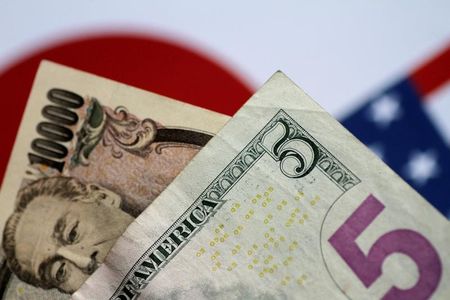Forex
Japanese yen firms, USDJPY slides amid intervention talk, rate cut hopes

Investing.com– The Japanese yen firmed sharply on late-Thursday, with the USDJPY pair dropping to a near one-month low amid speculation over potential currency market intervention by the government.
Strength in the yen also came as softer-than-expected consumer price index data battered the U.S. and ramped up expectations for a September interest rate cut by the Federal Reserve.
The pair- which gauges the amount of yen needed to buy one dollar- settled around 159 in early Friday trade, after dropping over 2% on Thursday. The pair was trading close to 38-year highs around 162 yen earlier this week.
Traders had expected USDJPY reaching 162 as line in the sand for government intervention.
The pair’s sharp drop sparked some speculation that the Japanese government had intervened in currency markets. Top foreign exchange diplomat Masato Kanda, who had spearheaded earlier intervention in the yen, offered scant cues on whether the government had stepped in this time.
Local media reports said the Bank of Japan had conducted a rate check for the yen against the euro- a move that could have heralded some currency market intervention.
The yen had weakened substantially over the past month as a string of weak Japanese economic readings drove up bets that the BOJ will have little headroom to tighten policy further this year.
The BOJ had hiked rates for the first time in 17 years in March, bringing them out of negative territory. But the move offered little support to the yen.
Middling inflation and soft business activity readings, coupled with a sharp downward revision for first-quarter gross domestic product data, all factored into doubts over the BOJ and weakness in the yen.
But the biggest point of pressure on the yen was high U.S. interest rates, which kept the dollar upbeat. Still, this notion now appeared to be easing as traders positioned for a September rate hike, especially after soft consumer price index inflation data on Thursday.

 Forex3 years ago
Forex3 years agoForex Today: the dollar is gaining strength amid gloomy sentiment at the start of the Fed’s week

 Forex3 years ago
Forex3 years agoUnbiased review of Pocket Option broker

 Forex3 years ago
Forex3 years agoDollar to pound sterling exchange rate today: Pound plummeted to its lowest since 1985

 Forex3 years ago
Forex3 years agoHow is the Australian dollar doing today?

 Cryptocurrency3 years ago
Cryptocurrency3 years agoWhat happened in the crypto market – current events today

 World3 years ago
World3 years agoWhy are modern video games an art form?

 Commodities3 years ago
Commodities3 years agoCopper continues to fall in price on expectations of lower demand in China

 Economy3 years ago
Economy3 years agoCrude oil tankers double in price due to EU anti-Russian sanctions


























